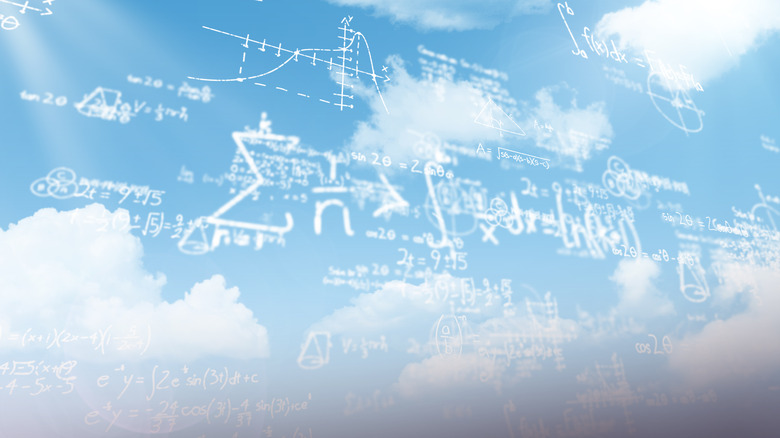Why Are Weather Forecasts Less Than Accurate?
A weather channel or website are the places most of us turn to when planning an event (via Forbes). After all, nothing can rain on your parade worse than an actual thunderstorm pouring down on the performers, making the happy hovering floats pop and sag. Truth be told, a rainy parade is a pretty sorry sight for those of us who've seen one. The same is true of a rainy carnival, beach day, or picnic.
For this reason, the local weather forecaster is our go-to insider, giving us the scoop on what's happening with the clouds, and telling us what to pack, wear, and plan, often with a modest degree of accuracy. But we've all been there — a forecast called for sunny skies and we got snow. A forecast called for snow and we got rain. Or how about when different weather apps are giving different forecasts for the same location on the exact same day? According to the Australian Broadcasting Corporation (ABC), weather forecasts are some pretty complex equations to solve and chances are, the weather forecaster 10 years from now won't be any better at getting this right than the one you currently have.
Surprise! It's a computer program
All this time, when watching the weather, you likely assumed that the person delivering the information was also the one gathering the information. While there is some truth to that if you're watching the weather on TV, ABC News' Nate Byrne reports that if you're scrolling an app or website on your phone, your forecast is likely the guestimate of one singular computer.
Unlike the National Weather Service, which refers to a crafty supercomputer hooked up to satellites, radar, buoys, and weather balloons, your smartphone's weather app is just occasionally checking one simulation and hoping that it's right. This is the reason you can get totally different forecasts for the same day when reviewing different apps. Have you ever looked at your phone and read that it was currently raining when in reality it was sunny and bright outside? This is the reason for that discrepancy as well. Whether or not you know it at home, the kind of equipment used when gathering information plays a pivotal part in the accuracy of your weather forecast. But that, too, can be a little bit cloudy.
The weather forecast is like a complex mathematical equation in the clouds
Do you know how the longer a math problem is, the harder it seems to solve? This is because with each added number or sign, there's a new opportunity to make a mistake and even the slightest mistake, such as adding two numbers incorrectly, calculating the sequence out of order, touching the calculator ever so slightly with the side of your thumb, and who knows what else, throws the whole equation off. According to ABC News, the weather is a lot like that, with many different variables to be considered. In fact, complex math equations are part of a series of tactics used by meteorologists to deliver weather guestimates to your flat screen.
Wonderopolis reports that this technique is commonly known as numerical forecasting. When supercomputers are involved, there's a whole lot of complex data crunching taking place behind the scenes. From land to sea and all across the globe, data is gathered in regard to temperature, wind speeds, hot and cold weather fronts, air pressure, humidity, and more. If even one of those measurements is off, this can throw off the accuracy of the entire forecast. And there's a great deal of room for error here because while we rely on some pretty sophisticated tech equipment such as anemometers, Doppler radar stations, and satellites, much of the data is reported by everyday viewers like me and you.
The pandemic is an unexpected culprit behind recent poor forecasting
If you've noticed the recent uptick in poor forecasting, it isn't just your imagination. Something strange is happening in the sky lately that's making the weather even more difficult to predict. Perhaps you've noticed but never given it much thought. According to the Washingtonian, the absence of commercial flights in the wake of the international pandemic has had an adverse effect on our ability to accurately predict the weather.
As the world was put on pause in 2020 due to COVID, commercial flights stalled to a halt and have not yet picked up the pace. Those same airlines that carry people to their coveted vacation spots also gather data from the sky and deliver it to your local weather reporter. Chuck Bell of WRC-TV spoke candidly on the subject, explaining, "Every modern jet is essentially a flying weather station, constantly sending back data — here is the altitude I'm at, and here is the temperature, the humidity."
McKinsey & Company reported in 2021 that pandemic-induced financial setbacks combined with fears of airborne illness and contagions could continue to stall commercial flights for years to come. From this perspective, you might not have an accurate forecast until 2025. This theory does have its fair share of critics, though, with many experts claiming commercial flight data was never abundant enough to make a massive impact on weather forecasts anyway.
The trouble with long-term forecasting
The shadow of doubt in weather forecasting gets a whole lot longer with each passing day. According to Science ABC, modern forecasts wow with a 90% rate of accuracy, so long as they reflect a five-day frame of time. It's only once we move past five days that things get a little hazy. Even so, your seven-day weekly forecast boasts some pretty decent odds, tipping the scales in favor of accurate predictions about 80% of the time. However, if you try to stretch that again to, say, 10 days, then you only have a coin's toss of a chance of getting things right.
According to ABC News, this is because small weather inaccuracies reflect bigger impacts over longer periods of time as more and more variables come into play. Due to the complex nature of the matter, this means that weather forecasts get less and less accurate not only by the week, but even by the hour or day (per Science).
We've come a long way in weather predicting accuracy
Meteorologists and forecasters get an unnecessarily bad rap because nobody likes a rainy picnic filled with soggy sandwiches. We tend to remember the times we unpacked all of our beach gear expecting a sunny swim only to hear rolling thunder in the background and have to scramble for the car with blankets and massive sun umbrellas in our arms. What we forget is all those times the forecasters got things right, which is ultimately the silver lining.
PHYS.org reports that weather predictions have grown in accuracy with each passing decade, to the point where our modern five-day forecasts are remarkably more accurate than the 24-hour forecasts available 40 years ago. When it comes to beach days, it's important to point out that marine weather forecasts are inundated with even more challenges due to the massive ocean standing between the buoys and the local forecaster (via So Far Ocean). Even so, by land and sea, we've made great strides in improving the odds of presenting semi-accurate weather forecasting, a sector geologists anticipate will gain even more traction as weather technology advances. From massive satellites stretching across the globe and even tracking through space, to supercomputers and everyday observers playing their part, the future of weather prediction looks bright. According to Science, we currently have access to several weather predicting techniques, including statistical forecasting, synoptic forecasting, persistence forecasting, and, of course, supercomputer forecasting, to name just a few.





